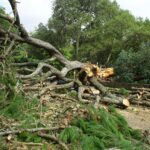At a glance
- Roots after tree removal are necessary to prevent fungal and root decay.
- Ways to remove roots after tree removal.
Stump removal is essential when trees are chopped down or if they fall; to prevent suckering and fungal root decay. The right equipment, technique, or weed killers can remove stumps without damaging them, even if they are large and heavy.
After tree removal, the root growth should also be controlled by killing them, removing them, or cutting them to prevent damage to driveways, retainer walls, and home foundations.
Each of these actions may solve your principal problem. Likewise, this article will provide you with several alternatives that could potentially solve your root management problems.
Tree roots are hard to remove, especially if the tree is large. The roots of these trees can extend 20 feet deep underground in the right conditions and sometimes even further. Most of the time, you have three options for removing tree roots after a tree is taken down:
- Remove the roots physically
- Apply chemicals to the roots
- hire a professional tree stump removal service
Remove the roots physically:
Physically removing a stump and its roots is the fastest but the most labour-intensive method. In general, you can remove tree stumps and tree roots by digging them out or by using a stump grinder. Tree roots may require a different solution depending on their size and type. It is best to use smaller stumps and roots for this DIY project.
Apply chemicals to the roots:
There are two ways to treat the tree’s roots. You can use a chemical herbicide, which works fast to eliminate the roots, or rock salt, which is a more natural option, but it takes longer to work and is equally effective. It is also possible to use Epsom salt or another form of salt that is highly concentrated. There is no point in using table salt for this purpose.
By using the saw, you can make a fresh cut across the stump. After that, saturate the tree’s outer layer (just behind the bark) with water. A water spray will help the herbicide reach the roots of the trees. Further, mix 50/50 glyphosate herbicide with water and spray the outer ring of the tree stump with it using your garden sprayer. Grass and nearby plants should not be exposed to the solution.
A second method is to fill each hole completely with rock salt, then add enough water to cover the hole without spilling and damaging other plants. Perform it several times a month. A deep three to four-inch hole can be drilled in the tree stump. You should also drill holes in any exposed roots on the ground.
Hire a professional tree stump removal service:
Hiring a tree service for stump removal has several advantages. You should hire a pro if you do not want to spend time digging and grinding the stump, or if you do not want to wait weeks or even months. The best part is your work is completed professionally.
In case you are unsure of the best method for your particular situation, Same Day Tree Works offers professional and affordable tree services such as tree removal, hedge trimming, tree pruning, and tree lopping. They provide tree services in various suburbs of Melbourne, including Malvern, Hawthorn, Camberwell, Toorak, and others. In addition to advising how to remove roots after tree removal, we will handle the entire project to your satisfaction.





